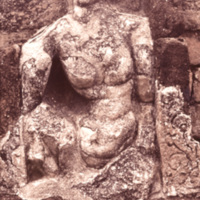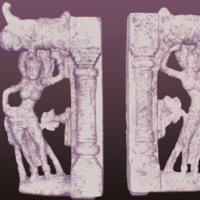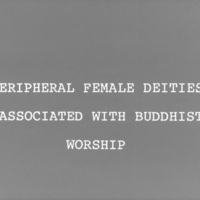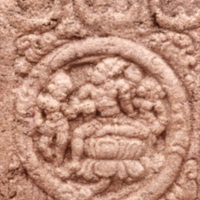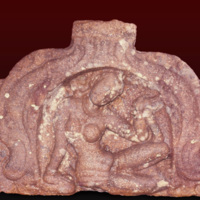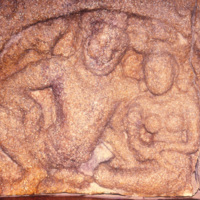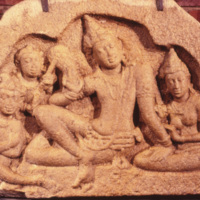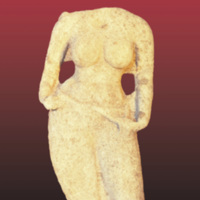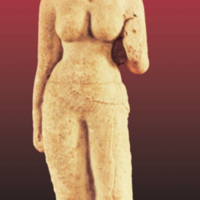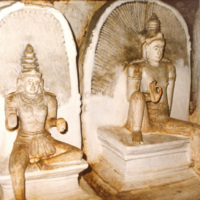Main Menu
AORC Libraries
Browse Archive Items (166 total)
Terra-cotta guardian goddess
Description: Perhaps it is a protective role which is played by the gods and goddesses placed in niches in the superstructure of the Vahalakadas (gateways) of the Kantaka Cetiya at Mihintale, Sri Lanka. This goddess made of terra-cotta and covered with lime plaster occupies a side niche, the central position being reserved for the male god. Stylistically this sculpture may be attributed to the early Anuradhapura period (2nd century B.C.E.-1st century A.D.).
Contributor: Co-Author: Seneviratna, Harsha
Collection: Women in Sri Lankan Sculpture and Painting
Tags: AISLS, Guardian Goddesses, ICES, PDWESLSP
Divine maidens (apsaras) as guardian goddesses
Description: Discovered near the so-called Buddhist railing site in 1987 and housed in the site museum of the Jetavanarama Cultural Triangle Project at Anuradhapura, Sri Lanka, is this miniature gateway. It is in the style of the Amaravati School of Art in India, and may belong to about the 3rd century A.D. The two apsaras or divine maidens, leaning against two flowering trees, are cast in the role of guardian goddesses.
Contributor: Co-Author: Seneviratna, Harsha
Collection: Women in Sri Lankan Sculpture and Painting
Tags: AISLS, Guardian Goddesses, ICES, PDWESLSP
Peripheral Female Goddesses associated with Buddhist worship
Description: This text explains the functional roles that many peripheral gods and goddesses held in the Buddhist system of worship. Many peripheral gods and goddesses held positions of veneration or occupied certain functional roles within Buddhism. This phenomenon is noticed in the earliest Buddhist sculpture in India, at Bharhut, Sanchi and later at Amaravati. Supernatural beings provided models for Sri Lankan sculptors and they adorn these temples in both a protective and a devotional capacity.
Contributor: Co-Author: Seneviratna, Harsha
Collection: Women in Sri Lankan Sculpture and Painting
Divine consorts
Description: The two females in the company of an unidentified male god carved on one of the pillars at the Atadage temple, Polonnaruva, Sri Lanka may also fit into the category of divine consorts (ca. 11th-12th century A.D.).
Contributor: Co-Author: Seneviratna, Harsha
Collection: Women in Sri Lankan Sculpture and Painting
Seated woman
Description: This single female carved in a niche, among the stone reliefs of the Isurumuniya Museum, Anuradhapura, Sri Lanka, can be dated between the 6th and 7th century A.D. on stylistic grounds.
Contributor: Co-Author: Seneviratna, Harsha
Collection: Women in Sri Lankan Sculpture and Painting
Consort of Bodhisattva
Description: This couple is carved within a stone niche, is in the museum at the Isurumuniya temple, Anuradhapura, Sri Lanka. The four-armed male figure is either a god or a Bodhisattva and the consort has on her lap a figure which has not been satisfactorily identified. Stylistically, this relief carving may be dated to the 6th to the 7th century A.D. period.
Contributor: Co-Author: Seneviratna, Harsha
Collection: Women in Sri Lankan Sculpture and Painting
Female consort
Description: Interpreted by some as a royal group and by others as a divine family, this bas-relief carved on hard stone is in the museum at the Isurumuniya temple, Anuradhapura, Sri Lanka. Central to the composition is the male figure and the female consort plays a supporting role even in a literal sense. A younger female is tucked behind in a still more subordinate position. It is dated between the 6th and 7th centuries A.D. by museologists.
Contributor: Co-Author: Seneviratna, Harsha
Collection: Women in Sri Lankan Sculpture and Painting
Headless image of a Buddhist Goddess
Description: This head-less image of limestone is of a Buddhist goddess. The gesture of holding her garment at the waist is unusual. Dates between the 6th and 7th centuries A.D. have been suggested by art historians.
Contributor: Co-Author: Seneviratna, Harsha
Collection: Women in Sri Lankan Sculpture and Painting
Torso of a Buddhist goddess
Description: Among those sculptures which have been tentatively identified as consorts of Bodhisattvas or else female goddesses within the scheme of Buddhist worship, is this fragmentary yet exquisite limestone torso of a life size image. Notable is the simple attire and the lack of ornamentation already noticed in respect of the majority of Buddhist goddesses. A tiny hole in the centre of her left palm suggests that she held something in her hand. A date between the 6th and 7th centuries A.D. has been…
Contributor: Co-Author: Seneviratna, Harsha
Collection: Women in Sri Lankan Sculpture and Painting
Tara, consort of Avalokiteśvara
Description: Today, this is the only instance of Tara worshipped as the consort of Avalokitesvara. Known as Biso bandara, her image, made of stucco, is housed together with the Bodhisattva in a single shrine. The sculptures seem to belong to the Kandyan period - 1529-1815 A.D.
Contributor: Co-Author: Seneviratna, Harsha
Collection: Women in Sri Lankan Sculpture and Painting



